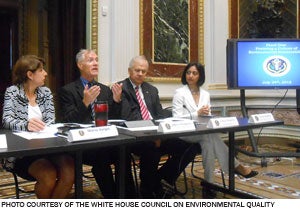Hospitals leaders say sustainability starts at the top
 Sustainability efforts in hospitals and health care facilities throughout the United States are gaining momentum, but the level of adoption is inconsistent or sometimes nonexistent because of a lack of commitment by hospital leaders.
Sustainability efforts in hospitals and health care facilities throughout the United States are gaining momentum, but the level of adoption is inconsistent or sometimes nonexistent because of a lack of commitment by hospital leaders.
The good news is that it can and does change. Educating leaders on sustainability's benefits and generating some early financial victories can convince hospital decision-makers that greening a hospital is a sound business decision and can be a great one.
Those are among key messages from the "Greening America's Hospitals" conference and panel discussions hosted by the White House Council on Environmental Quality in July.
The meeting focused on successes of the Healthier Hospitals Initiative (HHI) as well as challenges hospitals face when trying to launch sustainability programs. HHI includes 11 leading U.S. health systems that serve as a free guide and source of expertise on launching and growing sustainability programs.
During a panel discussion on "Fostering a Culture of Environmental Sustainability," Gary Cohen, president, Health Care Without Harm, and HHI founder, said the uneven adoption of sustainability at U.S. hospitals spurred the creation of HHI.
Members of that panel and a second that discussed "Transforming the Supply Chain" included senior administration officials, hospital administrators, business leaders and policy experts. They agreed that sustainability success starts at the top.
"The difficulty is you can't only 'bottom up' sustainability through the organization," said J. Knox Singleton, CEO, Inova Health System, Falls Church, Va., which is a member of HHI.
Getting the attention and approval of senior leaders is often the biggest challenge, but it is essential. "That sometimes is the hardest sale, but I do believe that is the most important sale," he said.
Leaders who do not recognize that hospitals can improve health and the level of care and save money, too, are "sort of off the ranch," said Brad Perkins, M.D., executive vice president for strategy and innovation and chief transformation officer, Vanguard Health Systems, Nashville, Tenn. He touted HHI's ability to provide a road map for success and encouraged other organizations to utilize the program.
Singleton and Jeff E. Thompson, M.D., CEO, Gundersen Lutheran, LaCrosse, Wis., also an HHI member, said there is a growing realization that a hospital's responsibility stretches outside its walls and into the community. Engaging staff as well as the community at large is key to successful sustainability programs, they agreed.
"Why would a CEO, senior administrator or community board member worried about health and their hospitals or their clinics dig into this issue? The answer is, it's your mission. Every one of our missions says: Improve the health and well-being of patients and the community," Thompson said.
Gundersen began its sustainability journey with the intent that it would save money and, thereby, lower the cost of health care while reducing energy use and pollution, he said. The health care system embarked on an ambitious sustainability program with a goal of using only renewable energy by 2014.
Thompson convinced Gundersen's board that sustainability was a worthy endeavor after convincing them that a one-time $2 million investment in energy conservation actions would result in $1 million in annual savings. The successful strategy fueled the start of its program that puts it at the head of the pack among health care systems.
Thompson recommended that hospitals start small. "Aim for easy wins," he said. "Then start expanding from that."
Jeff Ferenc is senior editor of Health Facilities Management.




